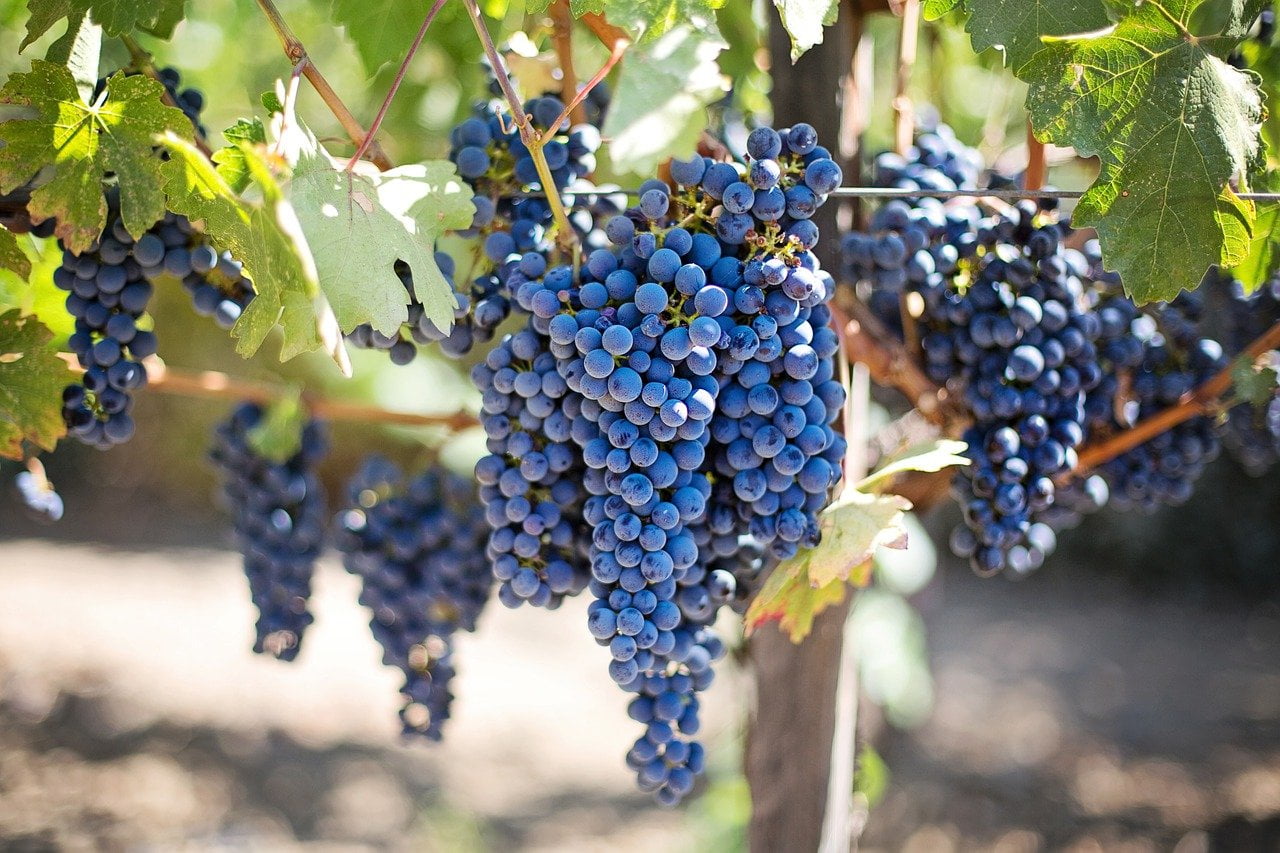Hi @graeme
Nice to see a fellow grape keeper! I have kept vines for years, most of the time, they are almost too vigorous to control, but then either time, they get powdery mildew or chlorosis like yours! Chlorosis is a lack of chlorophyll in the leaves, making stripes or yellow patches. Because the plant lacks chlorophyll, it can't convert sunlight into energy and grow p[properly. So chlorosis in grape vines deuces vigour and then lets other pests in as it acts as a vector for this.

You're right in understanding that most plants need a slightly acidic soil. Test your soil's pH and adjust it according to the plant's needs. Most plants prefer a slightly acidic to neutral pH (6.0-7.0). Add lime to raise pH or sulfur to lower it.
The quickest way is to make sure they have access to a rich peat free compost and or liquid plant feed that's well balanced. Tomato feed is high in potassium and usually used for fruits rather than foliage. So better to be used with the grape is in fruit.
What I would do is get these vines into either really large pots or the ground as they are super hungry once they get going. Vines tend to not do well in containers unless they are really big and constantly fed during the growing season.
Let's take a quick look at the three main deficiencies that cause grape chlorosis for other readers.
Correct Nutrient Deficiencies
Identify which nutrient is lacking and amend the soil accordingly:
- Iron Deficiency: Apply chelated iron or iron sulfate to the soil.
- Nitrogen Deficiency: Use a balanced fertilizer with a higher nitrogen content.
- Magnesium Deficiency: Add Epsom salts (magnesium sulfate) to the soil.
My recommendation would be a good balanced fertilizer and a liquid feed until they perk up. Then consider getting these specimens in the ground and then you'll be awash with foliage and in hot summers some grapes!
Below I've also listed a few common grape problems for other Ninjas who may be uncertain as to whether they have chlorosis or another grape problem.
1. Powdery Mildew
- Symptoms White, powdery fungus on leaves, stems, and grapes.
- Solutions
- Ensure good air circulation by proper pruning.
- Apply fungicides such as sulfur or neem oil.
- Remove and dispose of infected plant parts.
2. Downy Mildew
- Symptoms Yellowish oil spots on leaves, white downy growth on the underside.
- Solutions
- Improve air circulation and reduce humidity around plants.
- Use copper-based fungicides.
- Avoid overhead watering to keep leaves dry.
3. Black Rot
- Symptoms Black spots on leaves, shriveled black fruit.
- Solutions
- Prune and destroy infected plant parts.
- Apply fungicides like myclobutanil or mancozeb.
- Maintain good garden hygiene by cleaning up fallen debris.
4. Botrytis Bunch Rot (Gray Mold)
- Symptoms Gray mold on clusters, especially in humid conditions.
- Solutions
- Improve air circulation with proper pruning.
- Use fungicides such as fenhexamid or iprodione.
- Avoid overcrowding of vines.
5. Anthracnose
- Symptoms Small dark spots on leaves, stems, and fruit, leading to lesions.
- Solutions
- Apply fungicides like captan or chlorothalonil.
- Prune and remove infected plant parts.
- Ensure good air circulation.
6. Pierce’s Disease
- Symptoms Scorched leaves, stunted growth, and vine death.
- Solutions
- There is no cure; remove and destroy infected plants.
- Control insect vectors like sharpshooters with appropriate insecticides.
- Plant-resistant grape varieties.
7. Phylloxera
- Symptoms Yellowing leaves, galls on roots.
- Solutions
- Plant resistant rootstock.
- Use systemic insecticides if infestation is severe.
- Practice good vineyard sanitation.
8. Nutrient Deficiencies
- Symptoms Yellowing leaves, poor growth, small fruit.
- Solutions
- Conduct a soil test to identify deficiencies.
- Amend soil with appropriate fertilizers (e.g., nitrogen, potassium, magnesium).
- Ensure proper pH for nutrient uptake (5.5 to 7.0).
9. Bird Damage
- Symptoms Grapes eaten or pecked.
- Solutions
- Use bird netting to protect vines.
- Install scare devices like reflective tape or bird scarers.
- Harvest grapes promptly when ripe.
Happy Gardening.
Lee Garden Ninja
Hi @graeme
Nice to see a fellow grape keeper! I have kept vines for years, most of the time, they are almost too vigorous to control, but then either time, they get powdery mildew or chlorosis like yours! Chlorosis is a lack of chlorophyll in the leaves, making stripes or yellow patches. Because the plant lacks chlorophyll, it can't convert sunlight into energy and grow p[properly. So chlorosis in grape vines deuces vigour and then lets other pests in as it acts as a vector for this.

You're right in understanding that most plants need a slightly acidic soil. Test your soil's pH and adjust it according to the plant's needs. Most plants prefer a slightly acidic to neutral pH (6.0-7.0). Add lime to raise pH or sulfur to lower it.
The quickest way is to make sure they have access to a rich peat free compost and or liquid plant feed that's well balanced. Tomato feed is high in potassium and usually used for fruits rather than foliage. So better to be used with the grape is in fruit.
What I would do is get these vines into either really large pots or the ground as they are super hungry once they get going. Vines tend to not do well in containers unless they are really big and constantly fed during the growing season.
Let's take a quick look at the three main deficiencies that cause grape chlorosis for other readers.
Correct Nutrient Deficiencies
Identify which nutrient is lacking and amend the soil accordingly:
- Iron Deficiency: Apply chelated iron or iron sulfate to the soil.
- Nitrogen Deficiency: Use a balanced fertilizer with a higher nitrogen content.
- Magnesium Deficiency: Add Epsom salts (magnesium sulfate) to the soil.
My recommendation would be a good balanced fertilizer and a liquid feed until they perk up. Then consider getting these specimens in the ground and then you'll be awash with foliage and in hot summers some grapes!
Below I've also listed a few common grape problems for other Ninjas who may be uncertain as to whether they have chlorosis or another grape problem.
1. Powdery Mildew
- Symptoms White, powdery fungus on leaves, stems, and grapes.
- Solutions
- Ensure good air circulation by proper pruning.
- Apply fungicides such as sulfur or neem oil.
- Remove and dispose of infected plant parts.
2. Downy Mildew
- Symptoms Yellowish oil spots on leaves, white downy growth on the underside.
- Solutions
- Improve air circulation and reduce humidity around plants.
- Use copper-based fungicides.
- Avoid overhead watering to keep leaves dry.
3. Black Rot
- Symptoms Black spots on leaves, shriveled black fruit.
- Solutions
- Prune and destroy infected plant parts.
- Apply fungicides like myclobutanil or mancozeb.
- Maintain good garden hygiene by cleaning up fallen debris.
4. Botrytis Bunch Rot (Gray Mold)
- Symptoms Gray mold on clusters, especially in humid conditions.
- Solutions
- Improve air circulation with proper pruning.
- Use fungicides such as fenhexamid or iprodione.
- Avoid overcrowding of vines.
5. Anthracnose
- Symptoms Small dark spots on leaves, stems, and fruit, leading to lesions.
- Solutions
- Apply fungicides like captan or chlorothalonil.
- Prune and remove infected plant parts.
- Ensure good air circulation.
6. Pierce’s Disease
- Symptoms Scorched leaves, stunted growth, and vine death.
- Solutions
- There is no cure; remove and destroy infected plants.
- Control insect vectors like sharpshooters with appropriate insecticides.
- Plant-resistant grape varieties.
7. Phylloxera
- Symptoms Yellowing leaves, galls on roots.
- Solutions
- Plant resistant rootstock.
- Use systemic insecticides if infestation is severe.
- Practice good vineyard sanitation.
8. Nutrient Deficiencies
- Symptoms Yellowing leaves, poor growth, small fruit.
- Solutions
- Conduct a soil test to identify deficiencies.
- Amend soil with appropriate fertilizers (e.g., nitrogen, potassium, magnesium).
- Ensure proper pH for nutrient uptake (5.5 to 7.0).
9. Bird Damage
- Symptoms Grapes eaten or pecked.
- Solutions
- Use bird netting to protect vines.
- Install scare devices like reflective tape or bird scarers.
- Harvest grapes promptly when ripe.
Happy Gardening.
Lee Garden Ninja



